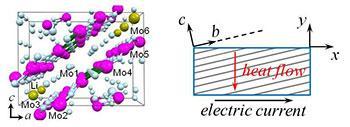 A new thermoelectric material may boost green technology. (Credit: Flickr @ Scot Nelson https://www.flickr.com/photos/scotnelson/)
A new thermoelectric material may boost green technology. (Credit: Flickr @ Scot Nelson https://www.flickr.com/photos/scotnelson/)University of Miami physicist Joshua Cohn and his collaborators report new surprising properties of a metal named lithium purple-bronze (LiPB) that may impact the search for materials useful in power generation, refrigeration, or energy detection.
“If current efficiencies of thermoelectric materials were doubled, thermoelectric coolers might replace the conventional gas refrigerators in your home,” said Cohn, professor and chairman of the UM Department of Physics in the College of Arts and Sciences and lead author of the study. “Converting waste heat into electric power, for example, using vehicle exhaust, is a near-term ‘green’ application of such materials.”

Lithium purple-bronze (LiPB) is a thermoelectric material comprised of aligned conducting, zig-zag chains of molybdenum and oxygen (left image, pink and white circles with green bonds). When an electric current was applied in a direction slightly misaligned with the chains (depicted as gray lines, right image), heat flowed perpendicular to the current, a phenomenon known as the transverse Peltier effect. The efficiency of this effect in LiPB was among the largest known for a single compound. (Credit: See citation at the end of this article)
Useful thermoelectric materials produce a large voltage for a given temperature difference, with the ratio known as “thermopower.” LiPB is comprised of aligned conducting chains. The researchers found that this material has very different thermopowers when the temperature difference is applied parallel or perpendicular to the conducting chains. When an electric current was applied in a direction slightly misaligned with the chains, heat flowed perpendicular to the current, a phenomenon known as the “transverse Peltier effect.” The efficiency of this effect in LiPB was among the largest known for a single compound.
“That such a large directional difference in thermopower exists in a single compound is exceedingly rare and makes applications possible,” Cohn said. “This is significant because transverse Peltier devices typically employ a sandwich of different compounds that is more complicated and costly to fabricate.”
As their motivation for the work, Cohn noted that metals with a similar electronic structure often exhibit interesting physics and the thermoelectric properties of LiPB had never been studied in detail. “The present material,” he said, “might be useful as it is, but the larger implication of our work is that the ingredients underlying its special properties may serve as a guide to finding or engineering new and improved materials.”
The findings are published in the journal Physical Review Letters (see footnote). Other authors of the study are Saeed Moshfeghyeganeh,Ph.D. student in the Department of Physics at UM; Carlos A. M. dos Santos, professor at the Escola de Engenharia de Lorena in Brazil and John J. Neumeier, professor in the Department of Physics, Montana State University.
Cohn, J., Moshfeghyeganeh, S., dos Santos, C., & Neumeier, J. (2014). Extreme Thermopower Anisotropy and Interchain Transport in the Quasi-One-Dimensional Metal Li0.9Mo6O17 Physical Review Letters, 112 (18) DOI: 10.1103/PhysRevLett.112.186602
